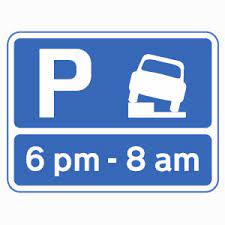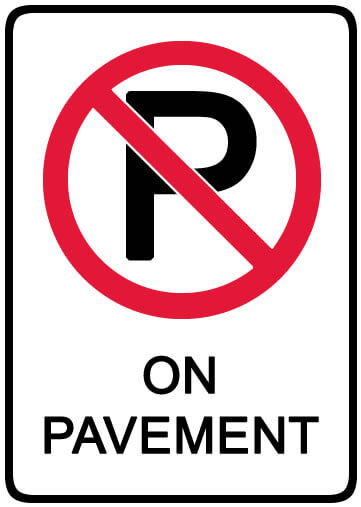Neighbour disputes can arise from various issues, and one common source of contention is parking on the pavement. Understanding the rules and regulations surrounding this matter is crucial to avoid future neighbour disputes. So if you are wondering what the parking on pavement law is in the UK, then keep on reading.
In this blog post, I will delve into the legal aspects of neighbours parking on pavements law in the UK, clarifying the definitions, implications, and exceptions to provide you with a comprehensive understanding of your rights.
What is the Definition of Parking on the Pavement?
Parking on the pavement refers to the act of leaving a vehicle partially or entirely on the sidewalk or footpath. You can get a fine even if just one wheel is on the pavement in London.
This practice can create significant problems, such as obstructing the path for pedestrians, particularly those with mobility challenges, parents with strollers, or wheelchair users.
The growing concern and public debate surrounding this issue highlight the importance of addressing it effectively.
You should ensure to review these rules/laws regularly as there are discussions about a blanket ban coming in prohibited pavement parking wherever you are in the UK.
However, many roads are narrow and the driver only has the option to park the car on the pavement.
Cars getting parked on pavements are a common source of frustration between neighbours.
I actually have this issue down my road and because the road isn’t wide enough, there are always cars parked on the pavement.
Is Parking on the Pavement Illegal in the UK?
Generally, the current laws and rules about parking on pavements are quite confusing as it depends on where you are in the country and if the local council has prohibited or permitted parking on the pavement.
Parking on the pavement is a subject of legal regulations in the UK but is generally only illegal to park on the pavement in London. It is not illegal to park on the pavement across the rest of the UK (unless specifically prohibited).
It’s no surprise that most car owners don’t have a clear understanding of the rules.
Even though the law only prohibits parking on the pavements in London, it doesn’t mean that you should park your car on a pavement elsewhere.
According to the Highway Code, which provides guidelines for road users, vehicles should not be parked on the pavement unless there are specific signs or markings permit it.
The Highway Code states:
145. You MUST NOT drive on or over a pavement, footpath or bridleway except to gain lawful access to property, or in the case of an emergency.
244. You MUST NOT park partially or wholly on the pavement in London, and should not do so elsewhere unless signs permit it. Parking on the pavement can obstruct and seriously inconvenience pedestrians, people in wheelchairs or with visual impairments and people with prams or pushchairs.
The general principle is to keep footpaths and sidewalks clear for pedestrians, ensuring their safety and ease of movement.
However, it is important to note that the legality of pavement parking can vary depending on the specific circumstances and location.
Different regions in the UK may have their own local bylaws or regulations that govern parking on the pavement. The councils can put up a Traffic Regulation Order (TRO) prohibiting parking on certain pavements but this will clearly be sign posted.
In some cases, local authorities may designate certain areas or sections where pavement parking is permitted. These designated parking bays are typically marked with specific signage or road markings. The sign is blue with a white sign of a car parked on the pavement.
However, it is important to strictly adhere to the designated parking bays and not encroach onto other parts of the footpath.
It is worth noting that the issue of pavement parking has received increased attention due to its potential impact on pedestrian safety and accessibility.
Several campaigns and initiatives have been launched to address the issue and advocate for stricter regulations.
Public opinion and local policies can influence the enforcement of parking on the pavement, leading to variations in its legality across different areas of the UK.
To ensure compliance with the law and avoid potential conflicts, it is recommended to park your vehicle entirely within designated parking spaces or on the road itself, where parking is permitted.
By doing so, you not only adhere to the regulations but also contribute to maintaining a safe and accessible environment for pedestrians.
If you are uncertain about the regulations in your area or have concerns about specific instances of pavement parking, it is advisable to consult with your local council.
They can provide accurate information regarding the laws and regulations applicable to your situation, ensuring that you are well informed and can navigate neighbour disputes or parking issues with confidence.

What About Parking on The Pavement Outside My House
Unless you live on a private road, the pavement will be owned by the council so the same rules apply.
If someone has parked on your private road then this is illegal and would be trespass and you would be well in your right to take action.
Issues Caused with Neighbours Parking on the Pavement in the UK?
When neighbours park their vehicles on the pavement, it can lead to various issues and conflicts within the community, especially in a residential area.
Some common problems that can arise with neighbours include :
- Obstruction of Pedestrian Pathways: Parking on the pavement can block or narrow pedestrian pathways, making it difficult for people to walk safely and comfortably. This can be particularly problematic for vulnerable pedestrians, such as the elderly, parents with strollers, or individuals with disabilities. It may force them to navigate onto the road, putting them at risk of accidents.
- Restricted Accessibility: Pavement parking can limit access to properties or obstruct entry and exit points, causing inconvenience to residents. It may impede the movement of vehicles, including emergency services or delivery vehicles, and make it challenging to load and unload items.
- Damage to Footpaths: Continued pavement parking can cause damage to footpaths and sidewalks. The weight of vehicles and the constant pressure exerted on the pavement can lead to cracks, uneven surfaces, or deterioration. Repairing such damage may require costly maintenance and can create further disruption within the neighbourhood.
- Reduced Visibility: Vehicles parked on the pavement can obstruct visibility for drivers, pedestrians, and cyclists. This lack of visibility increases the risk of accidents, especially at junctions, crossings, or areas with limited visibility. It compromises road safety for everyone in the vicinity.
- Neighbourhood Aesthetics: Pavement parking can negatively impact the visual appeal of the neighbourhood. Rows of parked vehicles on the pavement can create a cluttered and untidy appearance. This can diminish the overall aesthetic value of the area, affecting the pride and enjoyment residents derive from their surroundings.
- Strained Neighbourly Relations: Persistent pavement parking disputes can strain relations between neighbours. Continuous inconvenience and disregard for the concerns of others may lead to hostility, verbal disputes, or damaged community relationships. Resolving such conflicts requires open communication and a willingness to find mutually acceptable solutions.
It is crucial to address these issues arising from pavement parking to avoid neighbour disputes and to create a safe living environment.
By understanding and respecting the concerns of fellow residents, it becomes possible to find compromises and alternative parking arrangements that benefit everyone.

What Are the Consequences of Illegal Parking on the Pavement?
So can you get a fine for parking on the pavement?
Parking on the pavement illegally can have consequences. Local authorities and law enforcement agencies may take action to enforce the law.
Penalties may include a Penalty Charge Notice (PCN) or the issuance of parking tickets. If you receive a PCN then within a 28 days you either need to appeal the fine or pay it. The fine can be up to £70. If you pay the fine within 14 days then it will be £35.
If you fail to respond to the PCN then the fine can be increased and may take the matter to court.
Moreover, in extreme cases where parking obstructs emergency vehicles or poses significant risks, vehicles may be towed or clamped.

Dealing with Neighbour Disputes about Pavement Parking
Dealing with neighbour disputes related to parking on the pavement requires a diplomatic and constructive approach.
Here are some steps you can take to address and resolve the issue:
- Open Communication: Initiate a conversation with your neighbour to discuss your concerns about their pavement parking. Choose a calm and respectful setting to express your thoughts and feelings. Clearly explain how their parking may be causing inconvenience or safety hazards for pedestrians. Listen attentively to their perspective as well. The goal is to establish an open line of communication and find a mutually acceptable solution.
- Seek Mediation: If direct communication does not lead to a resolution, consider involving a mediator. A mediator acts as a neutral third party who facilitates discussions between you and your neighbour. They can help identify common ground, explore potential compromises, and guide the negotiation process. Mediation can be a cost-effective and less adversarial alternative to legal action, promoting understanding and reaching a satisfactory resolution. You can get quick and free quotes for a mediator on Bark.com. I have used Bark personally and highly rate it.
- Review Local Council Policies: Familiarise yourself with the parking policies and regulations set by your local council or authorities. Some councils may have specific guidelines or restrictions on pavement parking, which can serve as a reference point in your discussions with your neighbour. Understanding these policies can strengthen your position and help find a resolution that aligns with local regulations.
- Involve Local Authorities: If all attempts at resolution fail, and the parking on the pavement continues to be a persistent problem and is unsafe, you may need to involve local authorities. Contact your local council or the relevant department responsible for parking enforcement. Provide them with clear and documented evidence of the ongoing issue, such as photographs or written complaints. They can investigate the matter and take appropriate action based on the established regulations.
- Legal Advice: In complex cases or situations where legal guidance is required, it is advisable to consult with a qualified solicitor. They can assess your specific circumstances, review any relevant local bylaws or regulations, and provide personalised advice tailored to your situation. A solicitor can help you understand your rights, provide legal representation if necessary, and guide you through any legal processes that may arise from the neighbour dispute. A solicitor will also be able to help you if you have received a PCN and want to appeal it.
If you are having issues with a neighbour parking on the pavement that is dangerous then you might want to consider setting up a ring doorbell or outside security camera system to record evidence of the issues it is causing.
Remember, the goal is to resolve the dispute peacefully and amicably. It is in everyone’s best interest to maintain a harmonious neighbourhood environment while respecting the rights and safety of all residents.

Report Parking on Pavement UK
If you come across instances of illegal parking on the pavement, it is important to report them to the appropriate authorities.
By reporting such violations, you can contribute to maintaining the safety and accessibility of pedestrian pathways.
Here are some steps to follow when reporting illegal parking on the pavement:
- Gather Information: Collect as much information as possible about the offending vehicle and its location. Note down the date, time, and specific details of the incident. Keep your log of incidents in a separate evidence book that you can provide to the council, such as this notebook from Amazon. Take photographs or videos that clearly show the vehicle parked on the pavement, capturing its license plate and the surrounding context.
- Identify the Relevant Authority: Determine the appropriate authority responsible for parking enforcement in your area. This is typically your local council or a designated parking enforcement team. Visit the website of your local council or contact their customer service helpline to obtain the contact information or reporting procedures for parking violations.
- Provide Accurate Details: When reporting the incident, provide accurate and concise details of the violation. Include the location, date, and time of the offence, as well as a description of the vehicle involved. Attach the photographic evidence you gathered to support your complaint. The more specific and detailed your report, the easier it will be for the authorities to investigate and take appropriate action.
- Use Online Reporting Tools: Many local councils provide online reporting tools or dedicated apps for reporting parking violations. Check if your local council offers such services, as they can streamline the reporting process. These tools often allow you to submit details and evidence electronically, ensuring a faster response from the authorities.
- Follow Up: After submitting your report, it is advisable to follow up with the relevant authorities if necessary. Inquire about the progress of your complaint and any actions taken. Keep any correspondence or reference numbers related to your report for future reference.
- Community Engagement: Encourage your neighbours and community members to report any instances of illegal parking on the pavement as well. A collective effort can help address the issue more effectively and send a strong message about the importance of following parking regulations. Consider sharing information about reporting procedures and encouraging responsible parking practices within your community.
By reporting illegal parking on the pavement, you play an active role in maintaining the safety and accessibility of public spaces.
Your reports provide valuable information to the authorities, enabling them to enforce parking regulations and take necessary actions against violators.
Final Thoughts About Parking on Pavement Law UK
Understanding the parking on pavement law and regulations in the UK is essential for maintaining a harmonious neighbourhood and ensuring pedestrian safety, especially if in a residential area.
By familiarising yourself with the definitions, implications, and potential consequences, you can protect your rights and actively contribute to a conducive living environment.
Remember to approach neighbour disputes with diplomacy and seek assistance when needed.
For personalised advice regarding your specific situation and area, consult with the local authority.





Leave a Reply